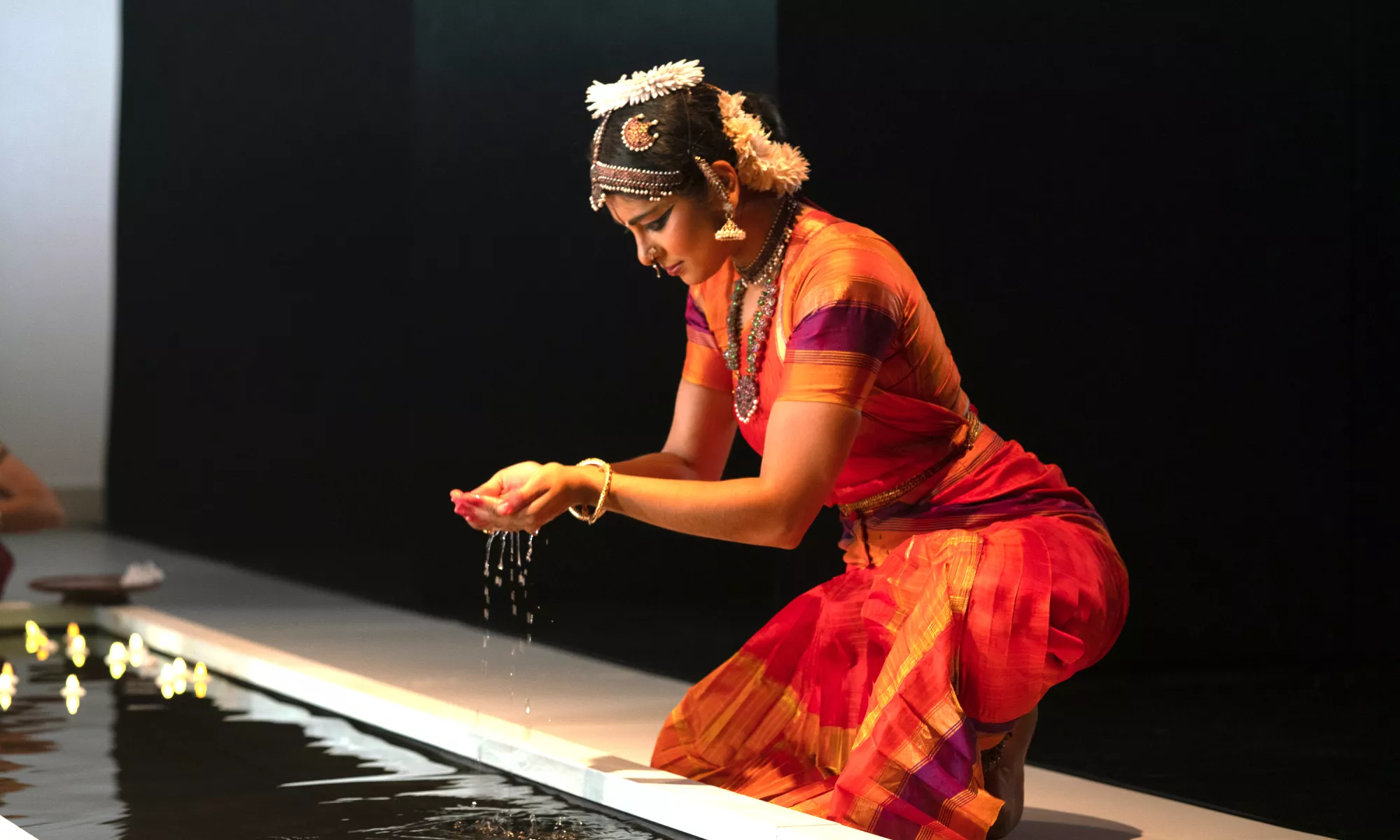
Q&A with Ragamala Dance Company
Tristan Bruns with Ranee Ramaswamy and Aparna Ramaswamy
When Ranee Ramaswamy first immigrated to the United States, moving from the state of Tamil Nadu in South India to Minneapolis in 1978, there were no outlets for Indian dance, so she created her own opportunities by teaching and eventually starting her own dance company, The Ragamala Dance Company, in 1992. Now, with the help of her daughters Aparna (co-director) and Ashwini (choreographic associate), the company has performed across the globe and to great acclaim, their multi-cultural take on the classical dance form of Bharatanatyam exciting and educating audiences about an ancient art form.
In the Ramaswamy’s most recent work, Fires of Varanasi: Dance of the Eternal Pilgrim, the subject matter is twofold: The work was created, in part, to honor the life and death experiences of immigrants living in a diaspora; but is also personal, with the creators drawing upon the experience of honoring Ranee’s late father’s wishes to have his ashes returned to the sacred city of Varanasi in India and scattered in the Ganges River.
In anticipation of Ragamala Dance Company’s upcoming one-night only performance of at the Harris Theater for Music and Dance, I asked Ranee and Aparna Ramaswamy about their connection to the work and spirituality, and how even ancient art forms can grow and evolve.
Tristan Bruns: What specifically inspired Fires of Varanasi?
Ranee Ramaswamy: Varanasi is a holy city for all Hindus. We believe that the Hindu god, Shiva, resides in this city—that he is always there with his wife. There are thousands of holy cites in India, but there are places which are more important—we call them swayambhu, which means that God was really there. Indians are extremely religious and that religiosity has not stopped for thousands of years. The most modern young Indians are still very religious, so billions of people go to Varanasi today to get blessings, to purify themselves, to take the ashes of their parents [to be released into the Ganges River]—like with my father’s ashes which my brother took to Varanasi. When my dad’s ashes went there, it became a closer city to me. It’s not only the river; nature becomes part of the divine—and you, when your body gets set on fire and ashes returned to the river. So we are actually returning to where we came with complete ritualistic embrace of nature. We have done so much research during the last two years of COVID and we feel such pride to be part of that tradition.
Aparna Ramaswamy: Rather than saying, “We want everyone to see Varanasi,” what we want is for our American audiences, our neighbors, our immigrant neighbors, to see the traditions and rituals that we carry as Hindus from our home country to our other homes. Varanasi becomes a symbol, it becomes the symbol that carries the pilgrimage, it carries the home of Shiva, it carries the Ganges, it carries the death rituals—it’s all “home” in Varanasi. For us, that was a larger symbol and is how we use it in the production.
TB: The subtitle of the work is Dance of the Eternal Pilgrim. Is the work referring specifically to Hindu pilgrims, or is there a deeper message about a universal pilgrimage? Are we all pilgrims?
RR: A seeker is a pilgrim. We are seeking transcendence in our tradition. In this particular piece, we are also incorporating a woman pilgrim, a devotee of Shiva. She wanted no body, no beauty, no bone, no nothing—male, female, nothing but to become an essence. It is a very universal idea to become one with the divine.
TB: Besides being an Indian art form, Bharatanatyam is also a Hindu art form; its roots stem from ancient sacred ritual. How much agency do you feel that you have over how you express yourselves through the dance?
AR: Dance was created in India as a way for everyone to be able to understand, enjoy and know the stories [of Hindu scripture]. If you think of that responsibility to carry forward a tradition and lineage—but also the communication with the divine and the communication between everyone and the divine—you think of the emotional potency that that conduit owns; that is agency and has always existed in this form. While we have an ancient tradition and these deep foundations, as long as one continues to understand the rules—what rules you are following and what rules you are bending—your agency is limitless because there is such a wide tradition to draw from.
TB: With a dance form as historical as Bharatanatyam, do you think that an audience needs to prepare beforehand and learn something about it to enjoy a performance?
AR: [Bharatanatyam] has an incredible amount of technique that it takes decades to and an incredible amount of rigor goes into it. But that’s just the first layer; the goal is to transcend the technique. …If a performer has the ability to move an audience member, it doesn’t matter if that audience has never seen Bharatanatyam or has spent a lifetime with Bharatanayam. If you are drawn to it, you will see more nuance, but any fantastic performer of Bharatanatyam should be able to draw you in. Our Indian classical art forms are based on the concepts of bhava and rasa—it’s the responsibility of the performer to communicate the emotional essence of that piece of work. There is an accompanying reaction that is experienced, not intellectually, but viscerally, by the audience member. It is that relationship that is the basis for all art.
RR: Emotionally, what pulls your heartstring is what makes you enjoy that. It’s like when you eat food, everybody has different tastes, but there are certain foods that are so amazingly simple yet have the ability to draw people to them. Excellence moves people, but excellence without emotion does not; if the dancer feels it, then the audience will definitely feel it.